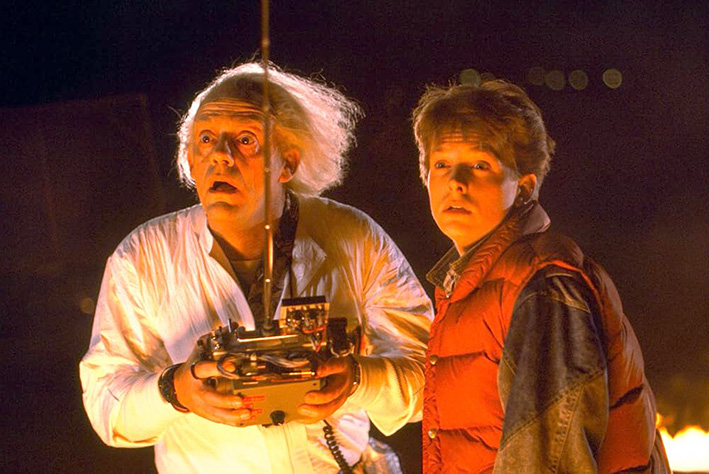Planning in a back-to-the-future media landscape

Opinion
Change is cyclical and recognising these cycles creates opportunity — after all, what’s old is new, what’s new is old. The chance to grow brands now is significant.
Where is 2025 going? Seems like January only finished last week, but already the mornings are light and clients are sending through Christmas briefs.
The frenetic pace of life in media planning and buying has given birth to the cliché that change is the only constant.
But one thing we don’t talk about enough is how change is cyclical and that recognising these cycles creates opportunity. Let’s face it, our industry has a bad habit of forgetting what we already know.
We’re undeniably in another back-to-the-future moment. What’s old is new, what’s new is old.
Resurgence of old tactics
At the top of the funnel, high-quality advertising formats are resurgent.
Time spent with TV advertising among younger audiences rose steeply last year, we enjoy historically high levels of commercial linear radio and thousands of new six-sheet sites are being installed. Even ultra-modern tech companies boast about how many 30-second TV ad slots they offer.
Moving down the funnel, the trend continues: print brands champion their scale in social media, video and digital audio ahead of their paper circulations. Despite it becoming easier to make programmes, top-quality presenting talent has never been in more demand, precipitating a flood of celebrities out of TV into newer channels where they have greater editorial agency.
The “new” players here, the creators themselves, are increasingly adopting older media sales tactics to win. They’re grouping into networks with one point of access, developing standard formats for brand integration, shortening lead times and sharing more data.
Finally, the platforms that grew on targeting and last-click attribution have firmly U-turned. They now advocate for fairly prosaic media tactics: let your ad creative do the targeting, speak to as many people as you can and use measurement techniques from the early 20th century.
As cookies die and lawmakers start to reflect the public’s wishes for privacy, the “modern” planning approach focused on audience and identity might not be the cure-all some have claimed.
Instead, we are slowly remembering what we once knew — context and creative are powerful levers.
AI may help us finally overcome the “context doesn’t scale” problem. And when we procure audience data, it’s increasingly from companies that have been around for generations, especially retailers.
Economic shifts
This is the result of a cyclical change in the economy. After all, adland is beholden to the money both punters and powerbrokers have to spend.
The uncertainty Europe has seen in the past three years has resulted in structural shift in interest rates and inflation, with historically low and steady rates that defined 2008-2022 coming to an end.
This halted the global gamble on growth by ventural capital and wealth funds. No longer could businesses pursue “growth now, profit later”. We’ve watched the platforms pivot from moonshots and the metaverse to quicker wins like fully automated advertising systems.
Almost in a flash, cheap, ad-free, high-quality TV is in retreat and we’re back to TV being bundled up into subs packages.
Ad formats, and the growth in their availability, also reflect this change. In the post-2008 era, ads were seen as bad for business; they hindered your platform’s monthly average user growth. Now, YouTube, Amazon and Netflix tout the strength of their 30-second formats and brands are paying near-TV money for longer host reads in digital audio.
We are busy relearning the stuff we had forgotten about media quality. Compare “new” attention metrics with older dwell-time stats; the correlation is striking. While the fashionable insight that not all reach is equal may be game-changing for some, it’s obvious to those who have ever studied metrics like “persistence” in TV.
For planners, this means the big questions have moved on.
Breaking through to new environments
In recent years, a lot of planning focused on how to cut through in “newer” environments, where the ad formats just weren’t very powerful compared with established media. Influencers, integrations, non-traditional formats and partnerships were all hacks to beat their constraints.
And because the growing environments of 2008-2022 offered weaker media, planners and buyers had to make budgets work harder; hence the growth of proprietary media and a flight to the lower funnel.
Now, the questions are how to account for quality when planning media, how to allocate budget across media owners offering similar placements and is the juice worth the squeeze on targeting? This is a return to quantitative planning.
In the mid-funnel, brands want to know how to plan across a “VISUAL” mix of creator-led channels: video, influencers, social clips, user-generated content, digital audio and live streams or events. This is holistic brand advertising planning to build synergy effects and make budgets work harder.
That’s hardly a new challenge, but more sophisticated than questions over influencer strategy or how to get into podcasts — both common asks in recent years.
Finally, as brands, led by retailers, move from being buy side to straddle the buy/sell fence, and the proprietary media opportunity matures, the likelihood for barter deals increases — signalling a return to one of the oldest value-creation tactics used by media buyers.
For those affected, the chance to grow their brands’ effective ad budget is significant.
So what’s old is new, what’s new is old.
And, as I always say, there’s never been a better time to be a media planner.
 Richard Kirk is chief strategy officer at EssenceMediacom
Richard Kirk is chief strategy officer at EssenceMediacom




